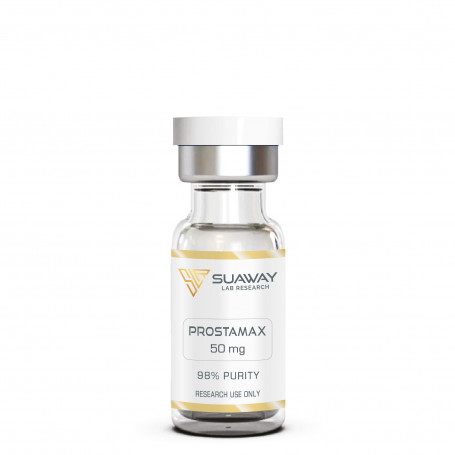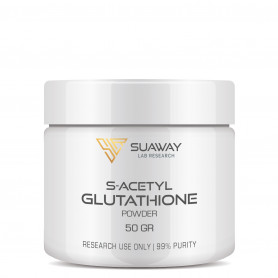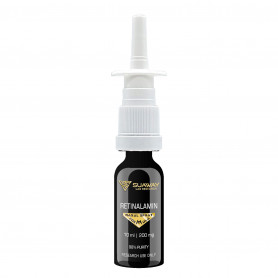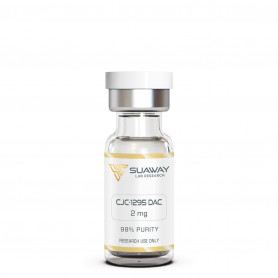PROSTAMAX - 50mg
The treatment of one of the most common urological diseases, a chronic aseptic prostatitis, is an exigeant problem. Used methods of pharmacotherapy are insufficiently effective and after treatment, as a rule, there comes a recrudescence. The new prostatotropic agent Prostamax is related to bioregulator peptides at experimental chronic aseptic inflammation of prostate gland. It is established that Prostamax reduces intensity of signs of a chronic inflammation, prevents development of sclerotic and atrophic processes and intensifies sexual activity of animals. Efficiency of the preparation Prostamax surpasses that among widespread prostatotropic agents derived from
Description
STRUCTURE
Sequence: H-Lys-Glu-Asp-Pro-OH
Molecular Formula: C20H33N5O9
Molecular Weight: 487.5 g/mol
Peptide purity: Greater than 98%
Other details: No TFA Salt, No Mannitol
Storage: Lyophilized peptide must be stored at -20°C and peptide solution at 4°C.
Prostamax has low oral and excellent subcutaneous bioavailability.
DESCRITPION
The prostate gland is the source of several common disorders including prostatitis and benign prostatic hyperplasia (BPH), wherein the prostrate gland becomes inflamed or enlarged. Prostatitis is defined as an inflammation or infection of the prostate gland. While prostatitis may be acute, associated with systemic findings of fever, chills and rigors, most cases of prostatitis are chronic and tend to be incurable with relatively frequent recurrences despite optimal standard therapy. Chronic prostatitis (inflammation or infection of the prostate) is common to all adult men. It is associated with virtually all cases of prostate cancer and is present in every prostate biopsy regardless of other findings. Chronic prostatitis may not cause significant symptoms in many men, but in others it can be a devastating disease that severely affects the quality of life of those afflicted. It is difficult to diagnose and even more difficult to treat.
The high efficacy of Prostamax in these patients is associated with the effect of the drug on the main pathogenetic mechanisms of prostatitis development. First of all, this relates to restoration of hemodynamics in the prostate gland, but the anti-inflammatory and immunotropic effects are also important. Microcirculatory disorders and congestive processes in the prostate gland are the most significant in development of chronic prostatitis. Moreover, hemodynamic disorders are important not only in pathogenesis of chronic abacterial prostatitis, but also in acute and chronic bacterial prostatitis.
Studies has shown that inflammation of the prostate gland starts most often as aseptic; however, in almost a quarter of cases, the inflammatory process already in the acute phase proceeds as a bacterial one. Bacterial prostatitis is probably caused by a decrease in the prostate gland resistance due to congestive disorders, causing, among other things, a decrease in the tone of the excretory prostatic ducts with urethro-prostatic refluxes, as well as deterioration in the bactericidal properties of the prostate secretion with subsequent infection. When studying the efficacy of Prostamax on experimental models of acute and chronic prostatitis, it was revealed that administration of Prostamax to animals at a dose of 0.1 mg/100 g of body weight for 5–10 days reduced leukocyte infiltration of the prostate tissue, improved the functional activity of the acini epithelium, and eliminated venule thrombosis. This effect was noted in both abacterial and bacterial prostatitis.
The study included 307 men aged 18 to 70 years, who received Prostamax at a daily dose of 5 mg or 10 mg intramuscularly 10 days. Clinical improvement, expressed in a decrease or elimination of pain and dysuria, an improvement in sexual function, was registered in almost all patients, and in 55.4% of them it was persistent and was noted during all 6 months of the follow-up. Among the 230 patients who complained of sexual dysfunction, 102 indicated complete recovery, and 96 noted an improvement.
Subjective data were confirmed by the results of laboratory and instrumental studies. The normalization of the size and consistency of the prostate gland were noted, as well as a decrease in the leukocyte counts in urine, ejaculate, and prostate secretions, and an improvement in urination. Similar results were obtained by other researchers who registered clinical improvement in 95% of patients treated with Prostamax. The efficacy revealed in the experiment and confirmed under clinical conditions made the prostate peptides one of the key drugs for treatment of patients with abacterial and bacterial prostatitis, both as a monotherapy and in combination with other drugs.
REFERENCES
В.Х. Хавинсон et al., "Tetrapeptide regulating prostate function, pharmacological agent based on thereof and method of its using" [В.Х. ХавинсонВ.В. МалининЕ.И. Григорьев]
T. Meskhi et al., "The influence of the peptide bioregulator prostamax on heterochromatin of human lymphocytes in situ" [PubMed]
T.G. Borovskaya et al., "Experimental studying of the drug efficiency Prostamax in the therapy of chronic aseptic prostatitis and its complications" [Scientific Research]
T.A. Dzhokhadze et al., "Deheterochromatinization of the chromatin in old age induced by oligopeptide bioregulator (Lys-Glu-Asp-Pro)" [PubMed]
M. Kiladze et al., "Microcalorimetric study of human blood lymphocytes culture at presence of copper, cadmium and prostamax" [PubMed]
V.K. Khavinson et al., "Peptides (Epigenetic Regulators) in the Structure of Rodents with a Long and Short Lifespan" [PubMed]
DISCLAIMER
This product is intendend for lab research and development use only. These studies are performed outside of the body. This product is not medicines or drugs and has not been approved by the FDA or EMA to prevent, treat or cure any medical condition, ailment or disease. Bodily introduction of any kind into humans or animals is strictly forbidden by law. This product should only be handled by licensed, qualified professionals.
All product information provided on this website is for informational and educational purposes only.












